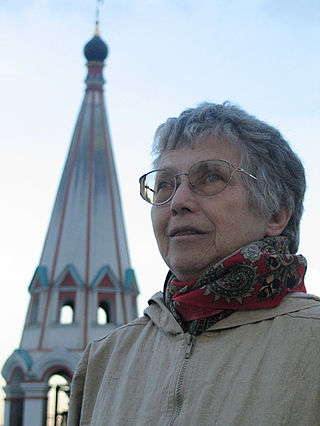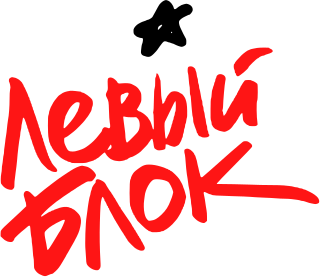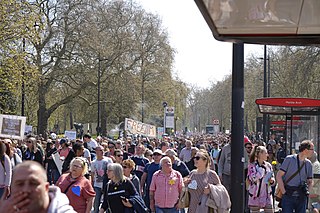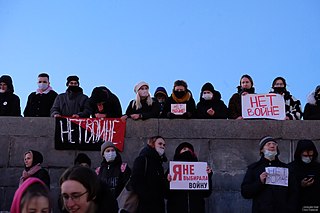
A protest is a public expression of objection, disapproval, or dissent towards an idea or action, typically a political one. Protests can be thought of as acts of cooperation in which numerous people cooperate by attending, and share the potential costs and risks of doing so. Protests can take many different forms, from individual statements to mass political demonstrations. Protesters may organize a protest as a way of publicly making their opinions heard in an attempt to influence public opinion or government policy, or they may undertake direct action in an attempt to enact desired changes themselves. When protests are part of a systematic and peaceful nonviolent campaign to achieve a particular objective, and involve the use of pressure as well as persuasion, they go beyond mere protest and may be better described as civil resistance or nonviolent resistance.

The Russian march is an annual demonstration conducted by Russian nationalist organizations in major Russian cities. They are usually conducted on 4 November, the Day of National Unity in Russia.

Ruby Doris Smith-Robinson worked with the Student Nonviolent Coordinating Committee (SNCC) from its earliest days in 1960 until her death in October 1967. She served the organization as an activist in the field and as an administrator in the Atlanta central office. She eventually succeeded James Forman as SNCC's executive secretary and was the only woman ever to serve in this capacity. She was well respected by her SNCC colleagues and others within the movement for her work ethic and dedication to those around her. SNCC Freedom Singer Matthew Jones recalled, "You could feel her power in SNCC on a daily basis". Jack Minnis, director of SNCC's opposition research unit, insisted that people could not fool her. Over the course of her life, she served 100 days in prison for the movement.

The 1968 Red Square demonstration took place in Moscow on 25 August 1968. It was a protest by eight demonstrators against the invasion of Czechoslovakia on the night of 20–21 August 1968 by the Soviet Union and its Warsaw Pact allies, crushing the Prague Spring, the challenge to centralised planning and censorship by communist leader Alexander Dubček.
James Peck was an American activist who practiced nonviolent resistance during World War II and in the Civil Rights Movement. He is the only person who participated in both the Journey of Reconciliation (1947) and the first Freedom Ride of 1961, and has been called a white civil rights hero. Peck advocated nonviolent civil disobedience throughout his life, and was arrested more than 60 times between the 1930s and 1980s.
Beginning on March 19, 2011, and continuing through the 2011 military intervention in Libya, anti-war protests against military intervention in Libya were held in many cities worldwide.
Protesters and dissidents in China espouse a wide variety of grievances, most commonly in the areas of unpaid wages, compensation for land development, local environmental activism, or NIMBY activism. Tens of thousands of protests occur each year. National level protests are less common. Notable protests include the 1959 Tibetan uprising, the 1989 Tiananmen Square protests and massacre, the April 1999 demonstration by Falun Gong practitioners at Zhongnanhai, the 2008 Tibetan unrest, the July 2009 Ürümqi riots, and the 2022 COVID-19 protests.
International demonstrations and protests relating to the Syrian Civil War have taken place outside Syria during the war.

The 2014 anti-war protests in Russia refers to a series of anti-war demonstrations opposing the Russian military intervention in Ukraine that took place in Russia in 2014. Protesters held two anti-war protest rallies on 2 and 15 March 2014. The latter, known as the March of Peace, took place in Moscow a day before the Crimean referendum. The protests have been the largest in Russia since the 2011–2013 Russian protests by the Russian opposition against the alleged electoral fraud committed by United Russia during the 2011 Russian legislative election. Reuters reported that around 20,000 people participated in the 15 March demonstrations.

The Left Bloc was a social movement uniting activists of the Russian left organizations. It was created at the end of November 2015 from a split in the Left Front. It is strongly critical of President Vladimir Putin.

Activists and artists taking part in the 2019–2020 Hong Kong protests use artwork, painting, music, and other forms of artistic expression as a tactic to help spread awareness about the events that have happened in the city. Individuals who create protest art are commonly referred to as the "publicity group" (文宣組). Creating protest art is seen as a peaceful, alternative way for citizens to express their views without participating in protests. Most members work under pseudonyms to protect their identity and stay in line with the movement's leaderless nature.

Sergei Leonidovich Tikhanovsky, also transliterated as Syarhey Leanidavich Tsikhanouski, is a Belarusian YouTuber, video blogger, dissident and pro-democracy activist. He is considered by Amnesty International to be a prisoner of conscience. He is known primarily for his activism against the government of Belarus's long-serving president, Alexander Lukashenko. In May 2020, he announced his intention of running for the 2020 presidential election, but he was arrested two days after the announcement, and his wife Sviatlana Tsikhanouskaya then ran in place of him as the main rival to Lukashenko in the contested election.
There have been several COVID-19 protests in New Zealand held since 2020, where people protested the government's response to the COVID-19 pandemic in New Zealand, in particular the lockdown measures in place in March–May 2020, August 2020, and August–November 2021 and the later vaccine mandates. The protests have been largely condemned by members of parliament, as well as local city and regional councils. Fears were also raised about the protests increasing the spread of the virus.

During the COVID-19 pandemic in the United Kingdom, numerous protests took place over the government's response.
Between 2020 and 2022 hundreds of people from all over Italy protested against COVID-19 regulations. The protests ended with the abolishment of the majority of restrictions in June 2022. After the 2022 Italian general election in September, the remaining restrictions were removed completely by the Meloni Cabinet after Giorgia Meloni began serving as Prime Minister in October 2022.

Several more pro-democracy organizations dissolved under the pressure of the national security law. The Hong Kong Confederation of Trade Unions additionally cited physical threats that had been reported by members. The disbandment of the Hong Kong Alliance followed the arrest of its leadership under charges of collusion with foreign forces, adding to earlier arrests of its lead figures. Student Politicism also dissolved.

Following the Russian invasion of Ukraine on 24 February 2022, anti-war demonstrations and protests broke out across Russia. As well as the demonstrations, a number of petitions and open letters have been penned in opposition to the war, and a number of public figures, both cultural and political, have released statements against the war.

The Beijing Sitong Bridge protest was a protest taken place on October 13, 2022, in Haidian, Beijing, China.

On 24 November 2022, a fire broke out in a residential high-rise apartment building in a Uyghur-majority neighborhood in Ürümqi, Xinjiang, PRC. Local authorities reported ten people, all Uyghurs, were dead and an additional nine were injured, though some raised concerns of underreporting. Journalists raised questions of whether Beijing's strict enforcement of the zero-COVID policy prevented residents from leaving the building or interfered with the efforts of firefighters. PRC authorities have denied these claims. The fire has been called a trigger of protests in several cities across China and in several other countries targeting the PRC government's zero-COVID policy, but in several instances also called for an end to Chinese Communist Party (CCP)'s one-party rule and for general secretary Xi Jinping to step down.

A series of protests against COVID-19 lockdowns began in mainland China in November 2022. Colloquially referred to as the White Paper Protests or the A4 Revolution, the demonstrations started in response to measures taken by the Chinese government to prevent the spread of COVID-19 in the country, including implementing a zero-COVID policy. Discontent had grown since the beginning of the pandemic towards the policy, which confined many people to their homes without work and left some unable to purchase or receive daily necessities.














